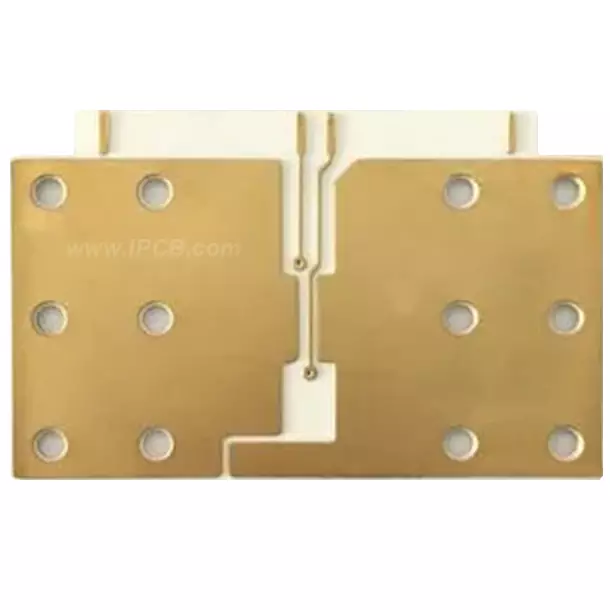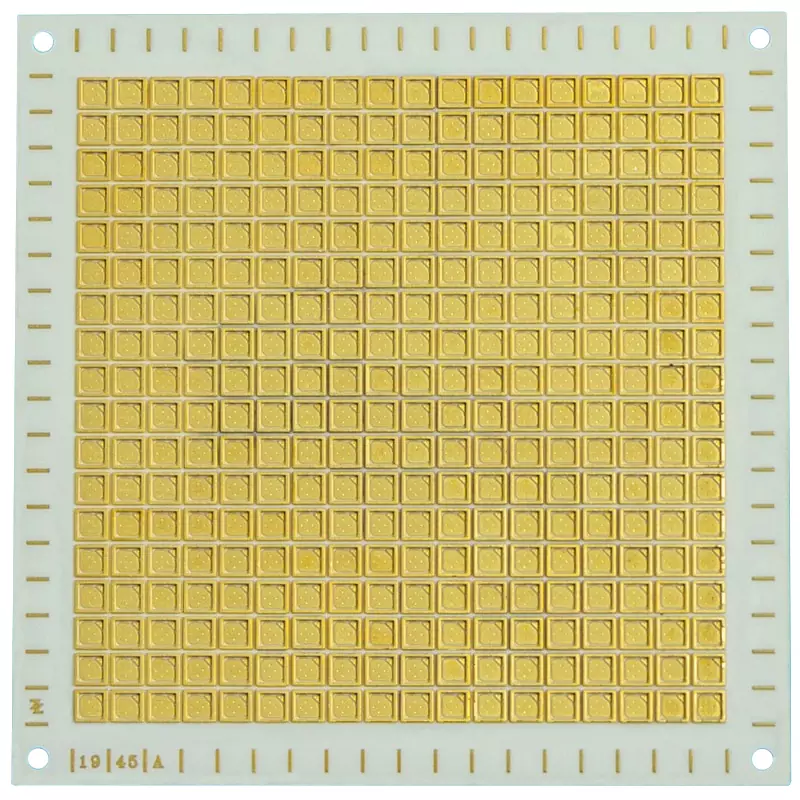

Substrate type: 99% Al2O3
Substrate thickness: 1.6mm
Conductive layer: copper, nickel, gold
Metal layer thickness: 70μm
Surface treatment: Nickel gold
Metal : 1Layer
Conductive hole: 0.5mm
Line width: 0.25mm
Application: High power component
Ceramic Aluminum Oxide PCB, as a high-performance substrate material, plays a crucial role in the development of modern industry and technology. The unique physical, chemical, and mechanical properties of Ceramic Aluminum Oxide PCB have made it widely used in multiple fields, providing solid support for technological progress and industrial upgrading in various industries.
Aluminum oxide ceramic is a ceramic material mainly composed of aluminum oxide (Al2O3), used for thick film integrated circuits. Alumina ceramics have good conductivity, mechanical strength, and high temperature resistance. It should be noted that ultrasonic waves are required for washing. Alumina ceramics are widely used ceramics due to their superior properties, and their applications in modern society have become increasingly widespread, meeting the needs of daily use and special properties.
Using Al2O3 as the main raw material, adding 6-30% of sintering promoters such as clay, magnesium oxide, calcium oxide, titanium oxide, etc., mixed and sintered at a temperature of 1450-1800 ℃. The more alumina content there is, the better the inherent characteristics and performance of alumina can be exerted, but manufacturing also becomes difficult with the increase of alumina content. The characteristic of alumina ceramics is that they still have good insulation performance at high temperatures. Pure alumina ceramics can be used at temperatures up to 800 ℃, and their mechanical strength is the highest among all oxide ceramics. They have high thermal conductivity and strong heat shock resistance.
In the manufacturing of Ceramic Aluminum Oxide PCBs, aluminum oxide (Al2O3) is used as the substrate material. Aluminum oxide is chosen for circuit boards because it has good thermal conductivity, high resistance, high hardness, high electrical insulation, and strong corrosion resistance. It is one of the most commonly used ceramic PCB in the market. How do we choose between 96% Al2O3 and 99% Al2O3?
1. 96% alumina
Cost effectiveness: Compared to 99% alumina, 96% alumina has lower costs and is suitable for cost sensitive projects.
Performance Balance: In most electronic components with low to medium power requirements, 96% alumina can provide stable and cost-effective performance.
The manufacturability of ceramic circuit board manufacturing: 96% alumina is easier to process than 99% alumina, suitable for cutting, drilling, and other processing, making it convenient to prepare various shapes of circuit boards.
Application areas: Suitable for low-power electronic components, sensors, capacitors, micro relays, microwave components, etc.
2. 99% alumina
High purity: With 99% or higher purity alumina, it brings higher chemical purity and density, suitable for scenarios with extremely high performance requirements.
Excellent performance: It has better thermal conductivity, ensuring that the material is uniformly heated as a whole, which helps to efficiently dissipate heat. Suitable for high-power LEDs, high-voltage integrated circuits, high-temperature sensors, high-frequency electronic components, etc.
Mechanical strength: High hardness, strong mechanical strength, able to withstand large forces and pressures, ensuring that the material remains sturdy in complex environments.
Corrosion resistance: Due to its high purity, it exhibits excellent resistance to acid and alkali corrosion, ensuring the longevity and durability of the material in corrosive environments.
High precision: It has better accuracy and stability in various electrical performance characteristics, suitable for high-precision electronic applications that require consistent and reliable performance.
3. How to choose 96% alumina or 99% alumina?
Project requirements: Firstly, clarify the specific requirements of the project for power, voltage, and temperature. In high-power, high-voltage, and high-temperature environments, 99% alumina is a better choice.
Cost considerations: Based on the project budget, weigh material costs and performance requirements. To consider costs, 96% alumina is better.
Application scenario: For high thermal conductivity, high corrosion resistance, and high mechanical strength, 99% alumina is preferred.
Multi functional design: If the device has multiple functional areas, consider using 99% alumina in high-performance areas and 96% alumina in areas with lower performance requirements to achieve a balance between cost and performance.
The advantages of Ceramic Aluminum Oxide PCB.
In the electronics industry, Ceramic Aluminum Oxide PCB has become the preferred material for the manufacturing of electronic components such as semiconductor devices and integrated circuits due to its excellent insulation performance and high temperature resistance. With the increasing miniaturization and high integration of electronic products, the performance requirements for substrates are becoming more stringent. Ceramic Aluminum Oxide PCB not only effectively isolates circuits to prevent electrical breakdown, but also maintains stable performance in high temperature environments, ensuring long-term stable operation of electronic products. In addition, its high strength and hardness also enable it to withstand complex machining processes, meet high-precision dimensional requirements, and become an ideal carrier material for electronic components such as chip resistors.
In the field of optoelectronics, Ceramic Aluminum Oxide PCB also performs well. Due to its high optical transparency and chemical stability, Ceramic Aluminum Oxide PCB is widely used in the manufacturing of optoelectronic devices such as lasers and LEDs. In laser equipment, alumina ceramic substrates can withstand the impact of high-energy laser beams, maintain structural stability, effectively dissipate heat, and extend the service life of the equipment. In the field of LED lighting, aluminum oxide ceramic substrates, with their excellent heat dissipation performance, help LED chips effectively dissipate the heat generated during operation, improving the luminous efficiency and lifespan of LEDs. In addition, its excellent airtightness enables LED lamps to maintain stable performance in various harsh environments.
With the rapid development of the automotive industry, the performance requirements for electronic components are constantly increasing. The application of Ceramic Circuit Board in key components such as automotive sensors and headlights is becoming increasingly widespread. Automotive sensors need to withstand various harsh environments such as high temperature, high humidity, and vibration, and aluminum oxide ceramic substrates meet these stringent requirements with their high temperature resistance, corrosion resistance, and good high-frequency performance. In terms of car headlights, the popularity of high-power LED headlights has put forward higher requirements for heat dissipation performance. Aluminum oxide ceramic substrates, with their good thermal conductivity, ensure the stable operation of LED light sources, improve lighting effects and service life.
In the aerospace industry, the application of Ceramic Aluminum Oxide PCB is equally important. Aerospace products have extremely high requirements for materials, not only requiring high strength, high hardness, high temperature resistance and other properties, but also requiring good radiation resistance, corrosion resistance and other characteristics. Aluminum oxide ceramic substrates have been widely used in key components such as aerospace devices and satellite communication equipment due to their comprehensive performance advantages. Its excellent heat dissipation performance and thermal matching ability provide strong guarantees for the stable operation of aerospace equipment in high heat flux density environments.
In the field of medical devices, Ceramic Aluminum Oxide PCB also plays an important role. Medical devices have extremely high requirements for material biocompatibility, corrosion resistance, and stability. Aluminum oxide ceramic substrates have become an ideal material for manufacturing high-end medical devices due to their excellent chemical stability and biocompatibility. For example, in implantable medical devices such as pacemakers and artificial joints, alumina ceramic substrates can not only withstand the complex environment inside the human body, but also ensure the long-term stable operation of the equipment, bringing better treatment effects and quality of life to patients.
With the continuous advancement of technology and the acceleration of industrial upgrading, the application fields of Ceramic Aluminum Oxide PCB will be further expanded. In the future, alumina ceramic substrate technology will pay more attention to optimizing material properties and innovating processing techniques to meet more complex and diverse application needs. With the continuous improvement of environmental awareness, green and sustainable alumina ceramic substrate materials will also become a research hotspot and future development direction.
Substrate type: 99% Al2O3
Substrate thickness: 1.6mm
Conductive layer: copper, nickel, gold
Metal layer thickness: 70μm
Surface treatment: Nickel gold
Metal : 1Layer
Conductive hole: 0.5mm
Line width: 0.25mm
Application: High power component
iPCB Circuit provides support for PCB design, PCB technology, and PCBA assembly. You can request technical consultation or quotation for PCB and PCBA here, please contact email: sales@ipcb.com
We will respond very quickly.